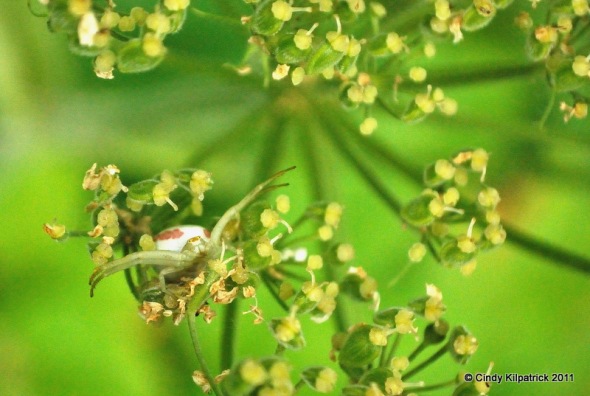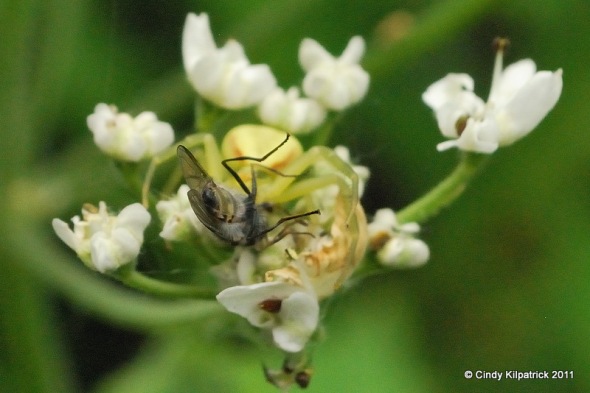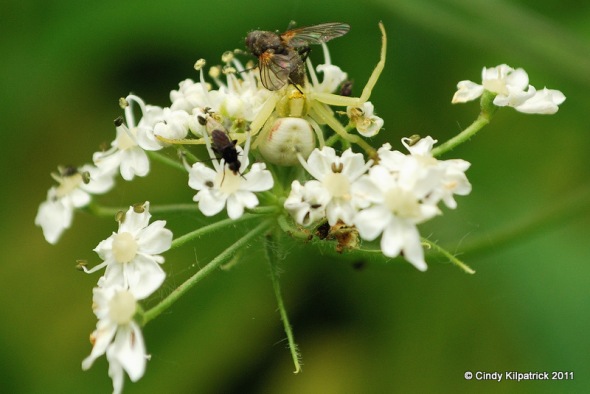Goldenrod Crab Spider
or Flower Spider
Misumena vatia
Goldenrod doesn’t grow on my hill and perhaps that’s why the Goldenrod Crab Spider is so easy to find on the cow parsnip, now that I know what to look for at least. In fact, I didn’t even know it existed until one day I was looking through my attempts to photograph the tiny blossoms of a cow parsnip umbel covered in tiny insects including an immobile moth. I don’t have a macro lens, so it is a challenge to photograph tiny things. Suddenly I noticed what appeared to be a small whitish ball with dark pink side-stripes.
Zooming in, I realized that it was a distinctly crab-like spider with a fly or tiny wasp in its clutches. I suspect that the moth had been a previous meal. Now I look on purpose. A banquet table in full bloom is always covered with insects busily nourishing themselves and among them might very likely be a goldenrod crab spider either waiting patiently with forelegs extended within the flowers for a hapless insect to land or crawl within range, or drinking as if from a large mug tipped for full satisfaction.
The crab spiders can move forward, backwards and sideways just like a crab and can spin webs although the males apparently only do that when the need arises to immobilize a mate, who, as is usual with spiders, would be much larger than him. Later, the female uses her silk-spinning skills to protect her eggs.
If you do find this spider on goldenrod, it would likely be yellow rather than white, as over several days the spider can transfer a pigment to its outer layer to switch between those two colours when it needs to blend into its chosen hunting blind.

Even though the petals have fallen and other insects have mostly abandoned this umbel, this female goldenrod crab spider has not quite given up.
Although the spider’s usual method of nourishment is to drink the still-pumping blood and then the liquified body of its paralyzed prey, from the following embedded video from Green Nature, it appears that she also subscribes to the ‘waste-not-want-not’ philosophy. I am impressed by her dexterity.
~~~~~~~~~~~~~~~~~~~~~~~~~~~~~~~~~~~~~~~~~~~~~~~~~~~~~~~~~~~~~~~~~~~~~~~~~~~~~~
Other Resources:
Bugs of Alberta by John Acorn & Ian Sheldon. Lone Pine, Alberta 2000
The Audubon Society Field Guide to North American Insects and Spiders by Lorus Milne and Margery Milne. Knopf (year unknown – publication page missing)
Talk about Wildlife on Weaselhead.org
Eurospiders
Bug Guide
Crab Spider on Chokecherry Blossom
BBC Nature – Crab Spiders







I ran out as soon as I read your post to check and see if there were any crab spiders on the goldenrod in my yard. I couldn’t find any but will keep looking. What a fascinating creature.
September 18, 2011 at 6:47 am
It truly is fascinating, Amy-Lynn. I wonder if it is too late in the season now. I haven’t seen one for some time but the cow parsnip has all gone to seed and so would not attract the insects that are this spider’s prey. These pictures were all taken in mid-July. I’ve read that although females guard their nest after egg-laying, they often die or leave the nest before the spiderlings hatch, since while guarding, they don’t eat. I have not found any information about their life cycle to suggest that the either adult overwinters, but the early instars must.
September 19, 2011 at 5:23 am
Hi Cindy, Thanks for filling in yet another gap in my personal database. I’ve been noticing these little guys for years (always with a tiny jolt of surprise as they are SO well camouflaged: ) and never knew what they were ’til now!
September 26, 2011 at 10:30 am
You are so welcome, Deb. I’m glad I coulld help. I say kudos that you saw them at all! I didn’t until I zoomed in on the photo. I’m blaming my horrible progressive lenses, but I know I have to continue to hone my observation skills.
September 27, 2011 at 4:31 am
Oh the wonderful things I learn on your blog !
October 21, 2011 at 4:10 pm
Your critters are interesting, it is a challenge if you don’t have a macro. I like how you camouflaged the first one. I tend to want to close my eyes when I use a macro. I want the photo but don’t like looking at them so close. LOL. 😉
October 22, 2011 at 7:20 pm
Pingback: Floral Visitors | Flandrum Hill